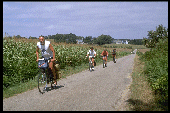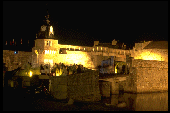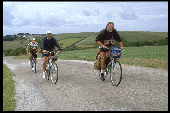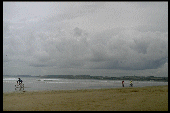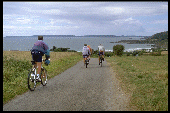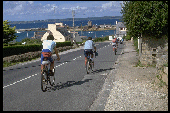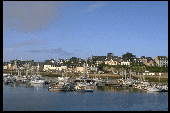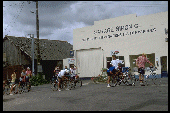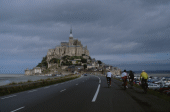|
|
|||||||||||||
|
FRANCE
2. Brittany
Auray-Concarneau-Camaret-Huelgoat-Guingamp-Dinan-Mt.
S.Michel.
Click on thumbnails to zoom
Brittany is a region that has a lot to please the
cycling tourist, but in exchange it requires a minimum of training, because
distances can be a bit long, unless you have at least a couple of weeks to do
the whole tour, and, even if its highest hills reach barely 400 meters,
there's hardly any flat terrain. It may also require a bit of patience to
endure the vagaries of the typically unpredictable West-European weather,
though on this point, you may have some pleasant surprise. After all,
Brittany happens to be France's second-most-popular destination for summer
holidays, with a lot of first-class seaside resorts. We start off our tour in Auray, a small town
situated at the bottom of a deep inlet, where a very steep escarpment
overlooks the old city and its harbour. Around here are some of France's most
important megalithic sites, the alignments of Menec, near Carnac,
composed of over a thousand menhirs. As we soon discover, however,
Carnac has also a nice beach and as the temperature today is well above 30
degrees C... (because of a design flaw, menhirs not only cast very little
shadow, but, even more annoyingly, their shadow turns while the menhir stands
still... somehow those poor cavemen couldn't bring themselves to make it work
the other way around). From Auray we begin a first
long stage -about 100 km.- along the coast, during which we will encounter
the sea only occasionally (if you want to see it more often, you'll have to
ride twice the distance...); mainly we are surrounded by a beautiful
countryside, still very much "continental" in appearance; every now
and then we pass through a little hamlet, and only a couple of times some
larger town like Quimperle' and Pont- Aven. The latter was made
famous by the painting school that gathered around Gauguin, but we
will remember it mostly for the worst road traffic ever encountered in a city
of less than a million people. We end today's ride in Concarneau, a
small city known for the fortified citadel, built at the entrance of the
harbour, and also for the Celtic festivals that are held almost daily (well,
maybe we have just been very lucky...).
The next day we head for the Cornouaille
peninsula (Sounds a lot like Cornwall, doesn't it?. Do they have one in
England too or something?), and we start to see the coast on a more regular
basis, until we get to Benodet, where, from the bridge that crosses
the wide Odet estuary, we are treated to a magnificent view of water,
land and sky (the bridge is the best point of view because, as long as you
stay on it, you can't see it...). From here on, the landscape starts
gradually to change, and becomes more "atlantic". We keep following
the coastline, which doesn't mean flat roads, on the contrary. It's a roller
coaster ride where we climb a series of rocky cliffs and descend into small
coves where sometimes we find a little harbour and a village; one of these,
only bigger, is Audierne, where we stop for the night.
The next day we ride around the Cap Sizun,
the westernmost tip of Cornouaille, where suddenly the landscape takes
on a sort of land's end air, until we get to the Pointe du Raz, a very
scenic rocky spike that plunges into the Ocean, amid cliffs and slopes where
a thin layer of topsoil sustains a very fragile ecosystem, on account of
which visitors must walk on marked paths at all times. The view from here
embraces the whole route of our tour's next two days. Right in front of us
there's nothing but sea. Since we choose to cycle insted of sailing, we are
forced to turn our cap around. The end of today's journey, Douarnenez,
is still some way away, but the road is mostly flat and straight, and, riding
in group, we make good time.
The following day it's another
story . The road is hillier than ever, but the reward are great views around
every corner (well, on top of every climb...) On our right is Douarnenez Bay,
on our left the inland mountains (so called), upon which emerges the bulk of Menez
Hom: it actually looks bigger than its 330 meters. But if the climbs
aren't long, the gradients are steep, sometimes more than 10 per cent: it's
another roller coasting day in Britanny... Crozon peninsula's
coastline is even more rugged than Cap Sizun's, the views change more
rapidly, until, at the bottom of the last plunge, we find ourselves in the
beautiful bay that shelters the harbour of Camaret, a place whose
undeniable charm helps to overlook some touristy excesses: the line of
buildings along the pier is a series of hotels, restaurants, bars and
souvenir shops.
On the two days that follow we visit a different Brittany, the inland part, the "mountains" , which are in fact hills, and not particularly high ones at that, but where the landscape in fact reminds us of higher regions of Europe: woods, pastures, streams, lakes, like the one on whose shores is built Huelgoat, the main town in the Monts d'Arrée area. Were it not for the fact that the sea is only one day away by bike, one would think to find himself somewhere in Switzerland. Not by the way people speak though. In their accent one can detect what I think may be considered as the French equivalent of an Irish brogue. Bretons speak a Gaelic related language, akin to the Celtic idioms of Ireland, Scotland and Wales. We cross Brittany from coast to coast until we get to Dinan, an exquisitely preserved medieval town, situated on the inland end of the Rance estuary. Around the mouth of the estuary there are some of the most beautiful stretches of coast, and some of the most renown beaches in the whole of Brittany
On
the last day of our tour we visit the world-famous Mont St. Michel,
where the tides of the bay have now taken second place to an even more
visible phenomenon, an inflow of tourists that knows no ebb, and which
manages to submerge regularly even the highest parts of the rock. We have
been told that the Mont can be alternatively part of Brittany or of Normandy
depending on the course that takes a little stream, the Couesnon,
which, following the tides, flows sometimes to the right and sometimes to the
left of the hill. In any case, since quantum physics do not apply to this
phenomenon, Mt. St. Michel can never be at the same time in Britanny and
in Normandy. After the visit we ride back to Dol, where there is
another abbey, not as famous as the one on the Mont, but still remarkable for
its stained glass windows. Click here to go to Part I: Loire Valley.
[Home Page]-|-[ France]-|-[ Ireland]-|-[ Italy]-|-[ Germany]-|-[ Scotland]-|-[ United States]
|


